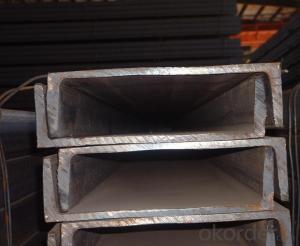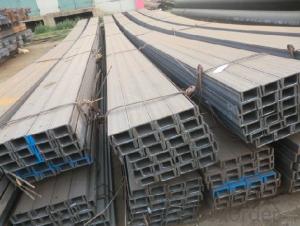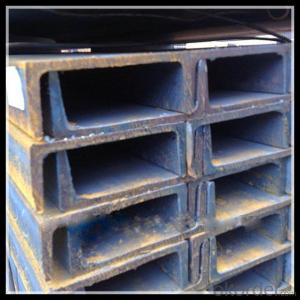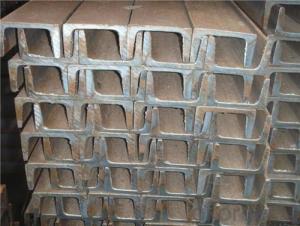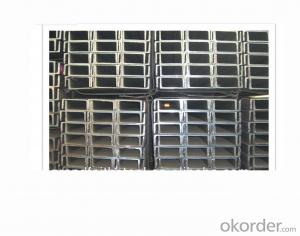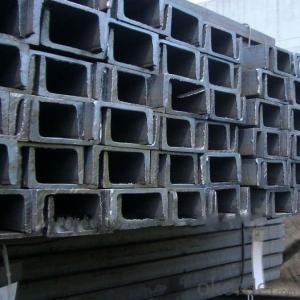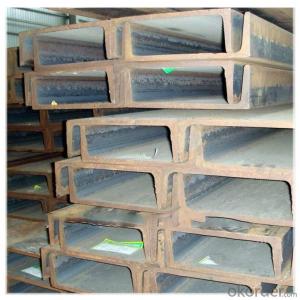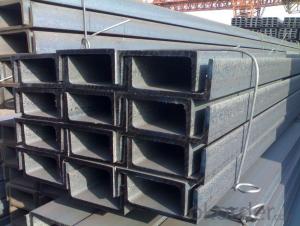Height 70mm the Thickness 8mm Surface and Length: according to the requirements of Channel Stee
- Loading Port:
- Qingdao
- Payment Terms:
- TT OR LC
- Min Order Qty:
- 15 m.t.
- Supply Capability:
- 500000 m.t./month
OKorder Service Pledge
OKorder Financial Service
You Might Also Like
U Channel Steel the Length Thickness According to the Customer
1、the details information of our Channel Steel
1)the ordinary model
Height: | 70-400mm |
Thickness: | 9-14.5mm |
Surface: | according to the customers’ requirements |
Length: | As customers’ requirements |
Size: | 90*37*4.5mm--400*104*14.5 mm . |
Punch: | Can be punched as customer's drawing |
Material: | Q195/Q235/ Q215/Q345/SS400/S235JR, A36,SS400,SS540 ASTM A36 and so on |
2)the light model
Height: | 70-400mm |
Thickness: | 6.4-8.0mm |
Surface: | Painted or Galvanized;according to the customers’ requirements |
Length: | As customers’ requirements |
Size: | 50*32*4.4mm--400*115*8.0mm . |
Punch: | Can be punched as customer's drawing |
Material: | Q195/Q235/ Q215/Q345/SS400/S235JR, A36,SS400,SS540 ASTM A36 and so on |
2、the Product Advantage
1) We can design the channel steel according to customers’requirements
2) We can manufacture under complete quality control system---ISO9001&SGS
3) We can installed with instruction of experienced engineers
4) Easy to assemble and dismantle
5) Eco-friendly material: can be used for several times and can be recycled
6) Shorter construction period, longer using time
7) High strength and stiffness, high weight bearing.
- Q: Can steel channels be used for solar panel mounting?
- Yes, steel channels can be used for solar panel mounting. Steel channels provide a strong and durable option for mounting solar panels, as they are capable of supporting the weight of the panels and withstanding various weather conditions. Additionally, steel channels can be easily customized and adjusted to fit the specific requirements of the solar panel installation. They offer a secure foundation for the panels and can be installed on rooftops, ground mounts, or other structures. However, it is important to ensure that the steel channels are properly installed and anchored to provide the necessary stability for the solar panels.
- Q: What are the common loadings considered in the design of steel channels?
- Steel channels are designed with consideration for several common loadings. These loadings consist of dead load, live load, wind load, and seismic load. 1. Dead load: The weight of the structure itself and any permanent fixtures or equipment is referred to as dead load. For steel channels, this encompasses the weight of the channel itself and any attached components. Dead load remains constant and is typically calculated based on the construction materials' weight. 2. Live load: Temporary weight or load that can vary in magnitude is known as live load. This includes moving or variable loads that steel channels may encounter, such as people, vehicles, or equipment. Live loads are usually defined by building codes or industry standards and can differ based on the specific application. 3. Wind load: Wind load relates to the forces exerted on steel channels by wind. The magnitude of wind load depends on factors like the structure's height, the channels' shape and orientation, and the local wind speed. Considering wind load in steel channel design is crucial for ensuring structural stability and safety. 4. Seismic load: Seismic load denotes the forces generated by earthquakes or other seismic events. These forces can induce significant stress and deformation in steel channels. Designing steel channels should account for the seismic risk of the location and the expected ground motion to ensure the channels can withstand these forces and maintain structural integrity. In summary, the design of steel channels takes into account these common loadings to guarantee their ability to safely support the intended loads and meet the necessary structural performance requirements. By properly considering and analyzing these loadings, engineers can design channels that are structurally sound and can endure the forces they encounter in real-world conditions.
- Q: What is the difference between channel steel and C steel?
- Section C is produced by cold rolling of strip steel, which is generally supplied by steel structure and thinner in thickness. In addition, their cross-section is not the same, the channel is straight side, C steel is curling.
- Q: How do steel channels contribute to the structural integrity of a building?
- The construction industry relies heavily on steel channels, which play a crucial role in maintaining the structural integrity of buildings. These channels, also known as C-channels or U-channels depending on their shape, provide essential support, stability, and strength to the overall structure. One of the primary functions of steel channels is their ability to bear heavy loads. They are commonly used in constructing beams, columns, and other structural elements that bear the weight of the building. Due to the high strength-to-weight ratio of steel, these channels effectively distribute and transfer loads, ensuring the stability of the building and preventing structural failures. Moreover, steel channels are highly versatile and can be easily fabricated into different shapes and sizes, making them suitable for a wide range of construction applications. They can be joined together through welding or bolting to create rigid frames, forming a robust framework for the building. This flexibility allows architects and engineers to design structures capable of withstanding various types of loads, including vertical, horizontal, and lateral forces. Additionally, steel channels offer excellent resistance to corrosion, which is particularly important in areas with high humidity or harsh weather conditions. Their durable nature ensures the longevity of the building, reducing the need for frequent maintenance and repairs. Another noteworthy advantage of steel channels is their fire resistance. Unlike other building materials, steel has a high melting point, making it less prone to structural failure during a fire. This characteristic enhances the safety of the building and contributes to its overall structural integrity. Furthermore, steel channels can contribute to the energy efficiency of the building. They can be designed to accommodate insulation materials, improving thermal performance and reducing energy consumption. By minimizing heat transfer and maintaining comfortable indoor temperatures, steel channels help create a more sustainable and cost-effective building. In conclusion, steel channels are essential components in ensuring the structural integrity of buildings. Their load-bearing capabilities, versatility, resistance to corrosion and fire, as well as their contribution to energy efficiency, make them a preferred choice for architects and engineers. By incorporating steel channels into the construction process, buildings can be constructed to withstand various forces and endure for a long time.
- Q: Are steel channels suitable for use in telecommunications towers?
- Yes, steel channels are suitable for use in telecommunications towers. Steel channels are known for their strength and durability, making them ideal for supporting heavy loads and withstanding extreme weather conditions. Additionally, steel channels can be easily fabricated and installed, providing a cost-effective solution for constructing telecommunications towers. They also offer excellent structural stability and can be designed to meet specific height and load requirements. Moreover, steel channels have a long lifespan and require minimal maintenance, making them a reliable choice for telecommunications infrastructure.
- Q: What are the different types of fire protection for steel channels?
- There are several different types of fire protection for steel channels, each with its own advantages and limitations. 1. Intumescent coatings: These coatings are applied to the surface of the steel channel and expand when exposed to high temperatures, forming a protective layer that insulates the steel and slows down the rate of heat transfer. Intumescent coatings provide a passive fire protection that can withstand fire for a specified period of time, typically ranging from 30 minutes to several hours. 2. Fire-resistant boards: These boards are made of mineral fibers or cementitious materials and are installed around the steel channels to provide fire resistance. They act as a barrier, preventing the heat from reaching the steel and maintaining its structural integrity. Fire-resistant boards can also provide thermal insulation and soundproofing. 3. Fireproofing sprays: These are spray-applied fire-resistant materials that form a protective layer on the steel channels. They are often made of cementitious materials, such as gypsum or vermiculite, and are designed to withstand high temperatures and prevent the steel from reaching its critical temperature. Fireproofing sprays are suitable for both indoor and outdoor applications. 4. Encasement: Steel channels can also be encased in concrete or masonry, providing a high level of fire protection. The encasement acts as a barrier, insulating the steel from the heat and preventing it from reaching its critical temperature. This method is commonly used in construction projects where fire resistance is a critical requirement. It is important to note that the choice of fire protection method depends on various factors, including the required fire resistance rating, the type of building, and the specific application. Consulting with fire protection experts and following local building codes and regulations is essential to ensure the appropriate fire protection measures are implemented for steel channels.
- Q: Can steel channels be used for creating support structures for telecommunications systems?
- Yes, steel channels can indeed be used for creating support structures for telecommunications systems. Steel channels are widely used in construction and engineering due to their strength and durability. They provide excellent support for heavy loads and can withstand various weather conditions, making them suitable for outdoor telecommunications installations. Additionally, steel channels can be easily fabricated and customized to meet specific design requirements, allowing for flexibility in creating support structures for telecommunications equipment such as antennas, cables, and other devices.
- Q: Can steel channels be used for roof structures?
- Indeed, roof structures can utilize steel channels. Construction frequently incorporates steel channels due to their robustness and endurance. They offer support for the structure and can function as purlins or rafters within roof systems. Steel channels possess the capability to endure substantial burdens and contribute stability to the entire framework. Furthermore, their fabrication and installation are hassle-free, rendering them a favored option for roof construction. Moreover, steel channels exhibit resistance to fire, corrosion, and pests, establishing them as a dependable and enduring choice for roof structures.
- Q: What is the minimum size of channel steel?
- Channel steel is a strip of steel with a cross section. Section steel with groove shape.
- Q: Can steel channels be used for framing in construction?
- Yes, steel channels can be used for framing in construction. They are commonly used as structural components in building frames due to their strength and durability. Steel channels provide stability and support, making them suitable for framing walls, floors, and roofs in various construction projects.
Send your message to us
Height 70mm the Thickness 8mm Surface and Length: according to the requirements of Channel Stee
- Loading Port:
- Qingdao
- Payment Terms:
- TT OR LC
- Min Order Qty:
- 15 m.t.
- Supply Capability:
- 500000 m.t./month
OKorder Service Pledge
OKorder Financial Service
Similar products
Hot products
Hot Searches
Related keywords











